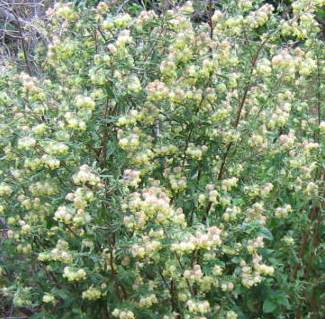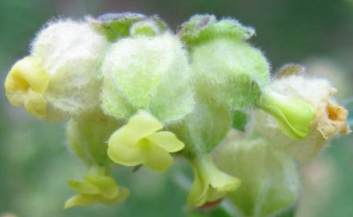Hermannia hyssopifolia
Hermannia hyssopifolia L.
Family: Malvaceae
Common names: eight-day healing bush (Eng.); pokkiesblom, agtdaegeneesbossie (Afr.)
Introduction
Hermannia hyssopifolia is a native of the Cape but it is known that this plant was grown in famous gardens in Europe more than 200 years ago. It was collected and exported in the very early days of Cape botanical exploration.

The hermannias are mostly low shrubs or trailers, and in South Africa they are found in a variety of habitats. Their fascinating flowers come in three basic forms, those with strongly twisted petals (poprosie, meaning doll's roses), those that are bell-like (klokkiesbos, meaning little-bells bush) and those with an inflated, balloon-like calyx. Hermannia hyssopifolia is an example of the third form.
Description
Description
Hermannia hyssopifolia is an upright to rounded shrub between 0.3 and 1.2 m tall, with multiple, long, slender stems. The young stems are purple and hairy, and older stems are reddish. The small leaves, 10-20 mm, are oblong, a pale grey-green, slightly furry and toothed at the tips. Flowers appear in loose clusters at the ends of short side branches.
The flower is attractive and quite fascinating: the calyx is swollen into a small, hairy balloon, 70-10 mm, with five small, lemon-yellow petals attached at the mouth in a neat, tight circle. Flowering time is spring (August to September).
The small seeds form shortly afterwards, enclosed in the now chartaceous (papery) calyx.

Conservation Status
Status
Although not considered threatened, in some areas the habitat of Hermannia hyssopifolia has been reduced by farming, for example in the Caldedon District where it is now mainly seen on road verges.
Distribution and habitat
Distribution description
Hermannia hyssopifolia is endemic to the Cape Peninsula and southern Cape where it is quite common on moist or sheltered slopes and is less often found on flat ground. On the Cape Peninsula it can be found growing on Lion's Rump and on the eastern side of Table Mountain on stony granite or clay slopes. Although it prefers the wetter areas of the southern Cape, its distribution extends into the Little Karoo where it tends to be found in seeps or on moist, south-facing slopes. It also extends into the Eastern Cape where the plant shows a change in leaf form. Its natural distribution would suggest that it is unlikely to tolerate frosts.
Derivation of name and historical aspects
History
There is an 18th century specimen of Hermannia hyssopifolia in the Linnean herbarium in Sweden but its exact date and the collector are not recorded. Later specimens were collected around 1830 by Franz Drège and Carl Zeyher, both important German plantsmen.
Paul Hermann was a 17th century physician and traveller and leading botanist of his day. He was still working on his collection of Cape plants when he died in 1695. Part of this collection can be found in the British Natural History Museum. His contribution to botany is commemorated in the genus Hermannia.
The species name hyssopifolia means with leaves like hyssop. The genus Hyssopus is a small group of Mediterranean and Asian aromatic herbaceous plants unrelated to the hermannias (they belong to the family Lamiaceae) which have been known since biblical times.
More than 90% of the approximately 200 species of Hermannia are found in southern Africa and the majority of these are in the Cape. A few other species occur in tropical Africa, Australia and Central or North America.
Hermannias were in the family Sterculiaceae but are now classified in the Malvaceae. There is a close relationship between the families Sterculiaceae, Malvaceae, Bombacaceae and Tiliaceae. Within these families, some of the characteristics that members have in common are now known to have evolved separately in different places and they are not necessarily inherited from a common ancestor. This places their status as families in doubt and the latest revision of this group (Bayer et al. 1999) redefine them as subfamilies of Malvaceae sensu lato (meaning in the broad sense).
Ecology
Ecology
Quite a few species of hermannias are palatable to herbivores and so in grazed veld they are not often seen in full bloom.
The pollinator of Hermannia hyssopifolia is not known but it has been suggested that it is moth pollinated. When ripe, the papery calyces fall off the plant and roll around in the wind, so dispersing the seed. The plant does not resprout after fire but relies on reseeding.

Uses
Use
Hermannia hyssopifolia is one of a number of aromatic shrubby plants known as agtdaegeneesbossie, meaning eight-day healing bush, as they are supposed to cure within eight days. Some other species of Hermannia have the name pleisterbos, meaning healing-plaster bush, also indicating medicinal properties. The Xhosa combined H. hyssopifolia with other plant extracts to make an ointment for erysipelas (a common skin infection) and the remedy remained in use in the Cape into the 20th century; it was also taken in the form of a tea as a blood purifier or as a remedy for syphilis.
Hermannia hyssopifolia, amongst other hermannias, was cultivated in Europe in the late 18th century, presumably for decorative or medicinal use. Since then, H. hyssopifolia has not enjoyed much interest in horticulture! Some of its relatives such as H. saccifera and H. pinnata are rewarding garden plants for indigenous gardeners today; H. grandiflora, which occurs naturally in the arid Karoo, is regarded as a very good garden subject as it is covered with large, scarlet flowers for several months of the year.
Growing Hermannia hyssopifolia
Grow
Not a great deal is known about propagating or growing Hermannia hyssopifolia. The following points are guidelines: it probably prefers a semi-shaded and damp or reasonably well-watered spot in the garden, and its natural distribution would suggest that it is unlikely to tolerate frosts. Cuttings can be taken from new growth in late winter to early spring (July and August). Seed can be collected in early summer (late October to November) and sown in autumn. Young plants would enjoy a light sand and loam mix with lots of compost for its water-retaining properties. The full-grown plant would probably respond to pruning back lightly after flowering but it should not be cut back hard.
It is a medium-sized shrub and, as it is quite upright, it would best be incorporated into an herbaceous border or bed, grouped with other plants that enjoy some moisture and light shade, such as Aristea ecklonii, Eucomis autumnalis, Thunbergia natalensis, Freylinia tropica, Hibiscus calyphyllus and Justicia campylostemon.
Acknowledgements:David Gwynne-Evans, Department of Botany, University of Cape Town, for generously helping with information from his own research and observations. See http://www.plantweb.co.za/Contributions/Daves_Hermannias/
References
- Adamson, R.S. & Salter, T.M. (eds). 1950. Flora of the Cape Peninsula. Juta, Cape Town & Johannesburg.
- Bayer et al. 1999. Support for an expanded family concept of Malvaceae within a recircumscribed order Malvales: a combined analysis of plastid atp B and rbc L DNA sequences. Botanical Journal of the Linnean Sociey 129: 267-303.
- Bredenkamp, C.L. 2000. Sterculiaceae. In O.A. Leistner, Seed plants of southern Africa : families and genera. Strelitzia 10: 539-541. National Botanical Institute, Pretoria.
- Gunn, M. & Codd, L.E. 1981. Botanical exploration of southern Africa. Balkema, Cape Town.
- Maythem Kidd, M. 1996. Cape Peninsula. South African Wild Flower Guide 3. Botanical Society of South Africa, Claremont, Cape Town.
- Plants of southern Africa, an online checklist. http://posa.sanbi.org/searchspp.php.
- Smith, C.A. 1966. Common names of South African plants. Memoirs of the Botanical Survey of South Africa No. 35.
- Verdoorn, I.C. 1972. The genus Hermannia. Veld & Flora 2: 43, 44.
- Watt, J.M. & Breyer-Brandwijk, M.G. 1962. Medicinal and poisonous plants of southern and eastern Africa. Livingstone, Edinburgh & London.
Credits
Jane Yeats
Kirstenbosch National Botanical Garden
January 2007
Plant Attributes:
Plant Type: Shrub
SA Distribution: Eastern Cape, Western Cape
Soil type: Clay, Loam
Flowering season: Spring, Early Summer, Late Summer
PH: Neutral
Flower colour: Cream, Yellow
Aspect: Full Sun, Morning Sun (Semi Shade), Afternoon Sun (Semi Shade)
Gardening skill: Challenging
Special Features:
Horticultural zones








Rate this article
Article well written and informative
Rate this plant
Is this an interesting plant?
Login to add your Comment
Back to topNot registered yet? Click here to register.